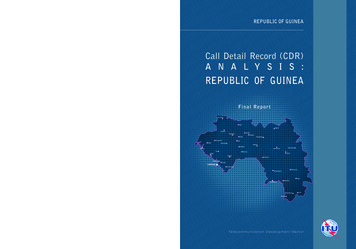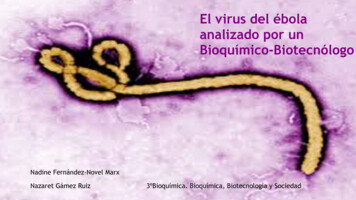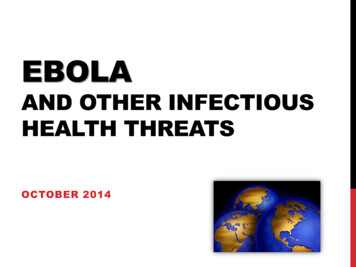
Transcription
EBOLAAND OTHER INFECTIOUSHEALTH THREATSOCTOBER 2014
WHAT IS EBOLA VIRUS DISEASE?Ebola Virus Disease (EVD) is: also known as Ebola hemorrhagic fever is severe and has a high fatality rate affects humans and non-human primates
TRANSMISSIONEbola is spread through direct contact with: blood or body fluids (urine, feces, vomit) of aninfected person with symptoms exposure to objects (such as needles) that havebeen contaminated with infected blood or bodyfluids infected animals
TRANSMISSION Ebola is NOT spread through the air or by water, or in general,by food. There is no evidence that mosquitos or other insects cantransmit Ebola virus. Only mammals (for example, humans, bats, monkeys, andapes) have shown the ability to become infected with andspread Ebola virus.
SYMPTOMS OF EBOLA INCLUDE:Fever (greater than 38.6 C or 101.5 F)Severe headacheMuscle painWeaknessDiarrheaVomitingAbdominal (stomach) painIn rare cases, unexplained hemorrhage (bleeding or bruising) Symptoms may appear anywhere from 2 to 21 days after exposureto Ebola, but the average is 8 to 10 days. Recovery from Ebola depends on good supportive clinical care andthe patient’s immune response. People who recover from Ebolainfection develop antibodies that last for at least 10 years.
CURRENT SITUATION(LATEST UPDATE: OCTOBER 3, 2014) Countries with outbreaks:Totals for Guinea, Liberia & Sierra Leone Total Case Count: 7470Total Deaths: 3431Laboratory Confirmed Cases: 4087 Countries with localized transmission:Nigeria Total Case Count: 20Total Case Deaths: 8Laboratory Confirmed Cases: 19 Countries with travel-associated cases:Senegal Total Case Count: 1Total Case Deaths: 0Laboratory Confirmed Cases: 1United States**In a traveler from LiberiaTotal Case Count: 1Total Case Deaths: 0Laboratory Confirmed Cases: 1
ISOLATION AND PPEUse Standard Precautions with ALL patients!Initially, all patients with a positive travel history (outside the U.S.)and symptoms will be placed in an Airborne Isolation room (negativepressure).Both Airborne and Contact Isolation Precautions should be followed.At this point the PPE to use includes: Gloves Gowns (fluid resistant or impermeable) N-95 respirator (if fit tested) with eye protection (goggles) OR apowered air purifying respirator (PAPR) Double gloving, disposable shoe coverings and leg coverings may beutilized for patients who have copious amounts of blood, body fluid,vomit or feces is present
ISOLATION AND PPEAfter the patient has had further screening and it is likely thatthey have Ebola, an individual will be assigned to monitorand record all individuals who enter the room.The patient will remain in a negative pressure isolation roomand the following PPE will be utilized (after just-in-timetraining on use of this type of PPE): Tyvek suits with boots and shoe covers Gloves (double gloving) N-95 mask and goggles/face shieldStaff will be designated and trained to use this type of PPE.
ENVIRONMENTAL CLEANING Use bleach surface disinfecting wipes to disinfect environmentalsurfaces in a room where a patient known or suspected to haveEbola is or has been located. All attempts to use single-use items should be made, do notremove patient care equipment from a room with a known orsuspected Ebola patient. Patients known or suspected to have Ebola are able to use thebathroom like any other patient. Sewage handling processes inthe United States are designed to inactivate infectious agentssuch as these. All linens and waste that is removed from a room where a patientis known or suspected to have Ebola will be placed in a biohazardbag. If there are copious amounts of blood, body fluid, vomit orfeces, double bagging may be required.
EBOLA IS NOT THE ONLY THREAT!World travel can bring diseases not usually seen in ourregion include: Measles MERS CoV: Middle Eastern Respiratory SyndromeAll patients who come to any of our Mission Health Systemlocations need to be screened for recent travel so thatpotential cases of these illnesses can be quickly identified.WHAT DOES THIS MEAN?A quick screen to determine the need to isolate patientspresenting with specific symptoms after traveling outside thecountry.Questions have been added to the Admission History and Triageforms at all acute care hospitals in the Mission Health System.
SCREENING TOOL(NURSING STAFF)
AMBULATORY ANDOUTPATIENT LOCATIONSAmbulatory and outpatient locations should also bescreening patients for a history of travel outside the U.S. If apatient has traveled outside the U.S. and has signs andsymptoms of illness: Place a mask on the patient If a patient is not in a private room and an isolation room isnot readily available, move to a private room immediately. Use a negative pressure room if possible. Call Infection Prevention at 828-776-5216
CLINICAL STAFF ROLEProtect yourself and your patients: Use Standard Precautions with ALL patients! Use airborne and contact isolation for any patients with a travelhistory screening and symptoms.Only share information about suspected or confirmed cases ofinfectious diseases on a need-to-know basis.Read and understand the system-wide PREP (PotentialRespiratory Epidemic Plan) plan in Compliance 360.Avoid using patient care equipment that is not single usedisposable or cleanable for patients that are suspected or knownto have Ebola.Complete travel history screening on all patients who present to aMission Health System location.
QUESTIONS?Refer to FAQ Handout attached in “Reference Resources”tab located in LMS Knowledge Center for this module.When in doubt, call Infection Prevention!QUESTIONS?: Call InfectionPrevention at your facility OR afternormal business hours (M-F 9-5), callthe on-call phone 828-776-5216
symptoms of illness: Place a mask on the patient If a patient is not in a private room and an isolation room is not readily available, move to a private room immediately. Use a negative pressure room if possible. Call Infection Prevention at 828-776-5216 .
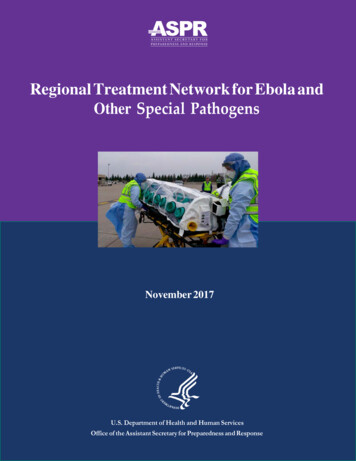
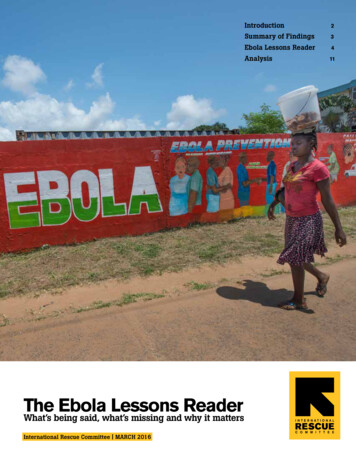

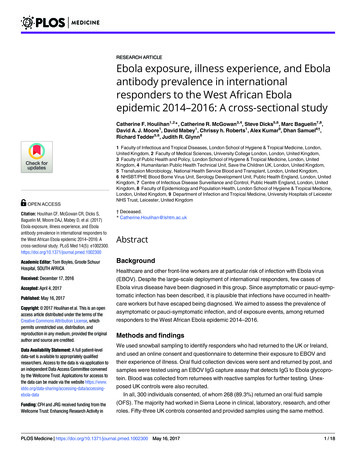
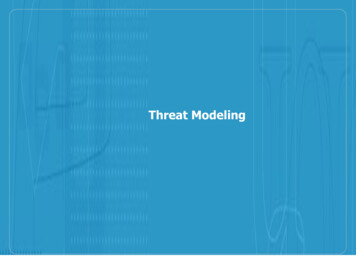
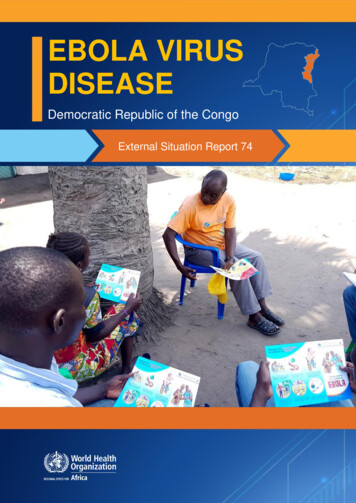
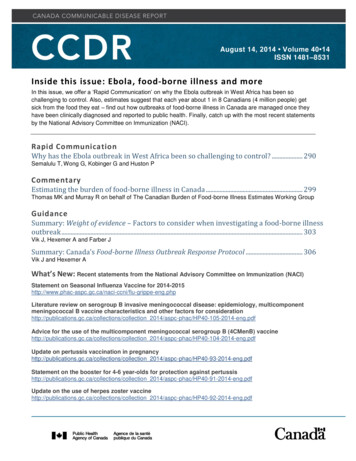

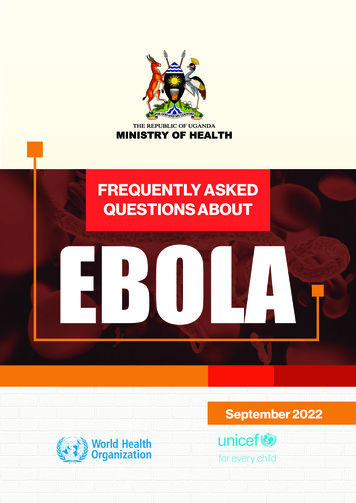
![f][triazin-4-amino] Adenine C-Nucleoside for the Treatment of Ebola and .](/img/14/ad1031184.jpg)
